Torus
![]()
The title of this article is ambiguous. For other meanings, see Torus (disambiguation).
A torus (plural tori, from Latin torus) is a mathematical object from geometry and topology. It is a bead-like shaped surface with a hole, so it has the shape of a tennis ring, also life ring, hoop or donut.
Examples of tori embedded in three-dimensional space are the rotation tori. Rotation tori are surfaces of rotation that are obtained by rotating a circle around an axis that lies in the plane of the circle and does not intersect the circle. If you rotate not only the circle line, but the whole circle surface, you get a full torus.
In other words, a rotation torus is formed from that set of points which fixed distance 
A torus can also be constructed by identifying the sides of a parallelogram. In this case, the right edge of the parallelogram is connected to its left edge and the top edge is connected to the bottom edge. This topology is also used by many computer games: If a game object leaves the playing field on one side, it reappears on the opposite side.
Both constructions are special cases of the general mathematical definition, which defines a torus as the topological product of two circles. This notion plays a role in numerous areas of mathematics, besides topology and differential geometry, it is important in Fourier analysis, the theory of dynamical systems (invariant tori in celestial mechanics), the theory of functions and the theory of elliptic curves, among others.
Rotation tori provide a concrete rotationally symmetric realization of this surface in three-dimensional Euclidean space. Significant for many applications in theoretical mathematics and physics is another embedding as a flat torus in four-dimensional space. This has the curvature zero and the maximum possible symmetry.
The torus is a two-dimensional surface. More generally, in mathematics one also considers the 

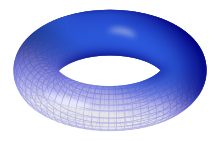
Torus
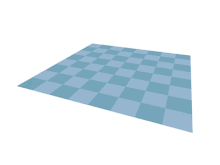
The torus is obtained by gluing opposite sides of a parallelogram together
Volume
The volume of the torus can be calculated as a volume integral over the Jacobi determinant (the determinant of the functional matrix). The Jacobi matrix for the parametrization of the torus can be given as follows:
It follows:
Thus, the functional determinant here is equal to the norm of the surface normal vector.
Thus, we obtain for the volume of the solid torus 
The formula for the volume can be interpreted as 





Considering only the inner part of the torus, which has a distance from the 

The outer part of the torus, which has a distance from the 

Surface
The surface of the torus with the above parameter representation is
This formula can be derived either with Guldin's First Rule from
or with the help of the surface integral
calculate. Here 
The torus bounds a 3-dimensional solid torus. The volume of the solid torus is 
Considering only the inner part of the torus, which has a distance from the 

The outer part of the torus, which has a distance from the 

Torus as surface of revolution
A rotation torus is a surface of revolution created by rotating a circle about an axis of rotation lying in the plane of the circle and not intersecting the circle. A rotation torus can be described as the set of points that are a fixed distance 


is described. Eliminating the root yields the 4th degree equation
One can 








Parameterization
The conversion of torus coordinates into Cartesian coordinates is
Torus coordinates are important in nuclear fusion technology, see nuclear fusion reactor.
Plane cuts
- Intersections with planes containing the axis of rotation are pairs of circles.
- Intersections with planes perpendicular to the axis of rotation are pairs of circles or a circle or empty.
- A plane parallel to the axis of rotation cuts out a spiral curve from a torus. In special cases this can be a Cassinian curve.
- An inclined plane touching two generating circles cuts out Villarceau circles.
Tori in descriptive geometry
In descriptive geometry, parts of a torus are used to construct transition surfaces between cylinders. The representation of a torus by its outline is found in outline constructions.

A radial ...

... and diagonally sliced torus in 3D
General definition
Let 


where 
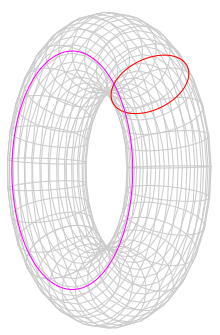
The 2-dimensional torus as a product of two circles.
Topological properties
Structure of a manifold
The 





Topological properties
It also follows directly from the definition that the 



The mapping 


Lie Group
The 1-sphere, conceived as a circle group, is also a Lie group. Since the product of several Lie groups with the componentwise multiplication is again a Lie group, the 
Embedded tori
Flat tori
Since the circle line 













There are other flat metrics on the torus besides the one described above. Flat 2-tori can be described by a parallelogram whose opposite sides are glued together. Equivalently, flat tori can be described as topological factor groups 




Elliptic curves over the complex numbers can be represented by Weierstrass parametrization as 

Flat tori in three-dimensional space
A 2-times differentiable embedding of the torus into the three-dimensional space cannot be flat, because the local extrema must be points of positive curvature. However, according to Nash's embedding theorem, there are fractal (only 1 times differentiable) embeddings of the flat torus into the three-dimensional space. These can also be constructed numerically.
Rotation tori in three-dimensional space
A rotation torus is a 2-torus embedded in 


Clifford-Tori
A Clifford torus is a special torus embedded in 



Furthermore, the images of 

Using stereographic projection, Clifford tori can also be thought of as tori embedded in the 
A Clifford torus is a minimal surface with respect to the standard metric on the 


Model of a flat torus: The paper only needs to be bent, not stretched.
Construction from a square or cube
Construction of two-dimensional tori from a square or parallelogram
Unlike the surface of a sphere, the torus can be mapped onto a flat rectangular surface without singularities.
Here, the right edge of the rectangle or square is stitched to its left edge, and its bottom edge is stitched to its top edge. This construction also works with any parallelogram. Many computer games, for example Asteroids or Pac-Man, also have this topology: If a game object leaves the playing field on one side, it reappears on the opposite side.
Construction of higher dimensional tori from a cube or parallelepiped
The three-dimensional torus or 3-torus is a parallelepiped or cube whose six opposite faces are interlocked in pairs.
The four-dimensional torus or 4-torus is a tesseract whose eight opposing cubes are interlocked in pairs.
In general, the 

![[0,1]^{n}](https://www.alegsaonline.com/image/40160923273b7109968df994dca832b91d957bf2.svg)


Again, instead of an 



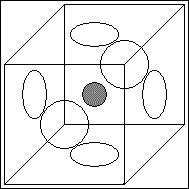
Features of the 3-Torus
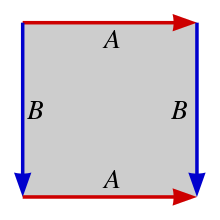
The torus is obtained from a square by gluing opposite sides.
Seven-color set
The seven-color theorem for the torus states that 7 colors are always sufficient to color any map on the surface of a torus so that no two adjacent countries get the same color.
This means that any graph that can be embedded in the torus has a chromatic number of at most 7 (see node coloring). Because the complete graph 
In the plane or on a spherical surface, fewer colors are sufficient. The four-color theorem states that four colors are always sufficient to color any map in the Euclidean plane in such a way that no two adjacent countries get the same color.

Animation of a torus. The surface is divided into 7 areas with different colors.

The surface of a torus can be divided into 7 areas in such a way that two areas touch each other. Therefore, in order to color this map so that no two adjacent areas get the same color, 7 colors are needed.
Algebraic torus
In the theory of algebraic groups torus is used in a different sense. There it means a group which is isomorphic to a finite product of copies of the multiplicative group of a body. To distinguish it, one then speaks of an algebraic torus in contrast to a topological torus.
For example, in toric geometry, the study of toric varieties, a torus is usually an algebraic torus.
Application examples
A life ring with outer diameter 76 centimeters and inner diameter 44 centimeters has the shape of a torus. It therefore has a fixed distance 

This results in the volume and the surface area:
- Volume:
- Surface:
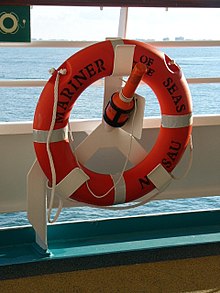
A life ring has the shape of a torus.
See also
- Dotted torus
- Torus node
- Stanford Torus
- Torus antenna
- Spindle torus
- Dupin cyclides
Search within the encyclopedia
















